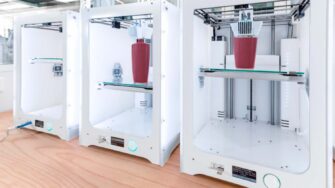L’Oréal, one of the largest global beauty and cosmetics companies spoken about its expanded use of 3D printing to aid its design and manufacturing.
L’Oréal has long embraced 3D printing, using digital manufacturing to reduce time to market for new products, bring added value to customers, and help keep its manufacturing plants running smoothly.
“We use 3D printing with the key focus on improving agility within the company to get products to market faster,” says L’Oreal additive technical manager Matthew Forrester.
“The faster we can go from an idea to a prototype, the faster we can iterate and validate it. 3D printing helps us to speed up this process and get a better product at the end of the development cycle.”
Prototyping remains the largest use case for 3D printing at L’Oréal, with thousands of prototypes produced for its design teams each year at its 3DLab in Clichy, France.
Managing this production volume has been no mean feat for the 3DLab’s team. A typical scenario of ordering a prototype would require engineers at L’Oréal to CAD files and accompanying emails with production requirements to the 3D printing lab.
Some designers would even prefer to transfer files in person using USB sticks.
In the 3DLab, managers would then have the challenge of calculating the cost of orders and managing all the jobs.
“The costing was fixed per part, which was sometimes dissuasive for smaller components. If a customer ordered several hundred parts, a special price would have to be created to reflect this,” Forrester explains.
“To accelerate time-to-market even further, we needed to eliminate duplication of effort and reduce low value-added activity.
 “Without a leaner approach to managing our 3D printing workflow, there was no way for us to achieve these goals. We knew that we could optimise our processes by using software for order submission and handling.”
“Without a leaner approach to managing our 3D printing workflow, there was no way for us to achieve these goals. We knew that we could optimise our processes by using software for order submission and handling.”
To do this, L’Oréal adopted AMFG’s MES and workflow management software, which it decided would give it the ability to offer custom development across its sites and its modular functionality.
“We wanted to have a scalable solution, with which it’d be possible to start small and then add modules as our technology evolved and matured. This is something we have found with AMFG,” explains Forrester.
An AMFG web request portal enables engineers and designers at L’Oréal to order and re-order 3D-printed parts, using their personalised dashboard which also highlights things like the status of their orders online.
“AMFG allows engineers to place an order by dragging and dropping a 3D file in its native format, so we don’t have to go through an additional file conversion step,” says Matthew.
Once the order is placed, L’Oréal’s 3D printing lab managers can track all incoming orders through AMFG’s project management tools. The backend system also enables project managers to analyse, repair files and price parts.
A universal file viewer, allowing anybody in the team to quickly check 3D files before placing orders and without having to use any file conversion software.
The 3D print Lab managers were able to implement a three-tier part size pricing strategy based on print time, helping them calculate 3D printing costs more accurately and automate yet another low value-added task for the lab assistants.
Forrester confirms, “AMFG’s workflow management solution allowed us to automate previously manual steps, gain greater visibility and better coordinate our internal processes.
“With a centralised software solution, internal billing, reporting, and stock management data is automatically filled, when parts are ordered, saving huge amounts of time and effort.”
With more reactive additive manufacturing, L’Oréal looks to further bring added value to the customers, such as new geometries, new materials and localised production.






